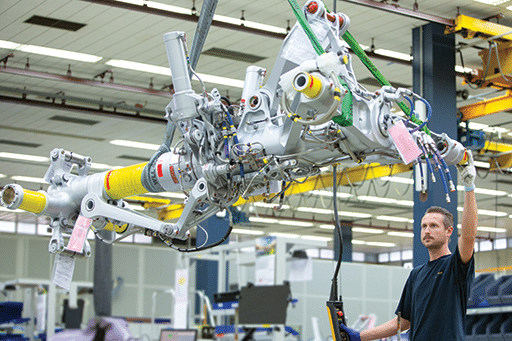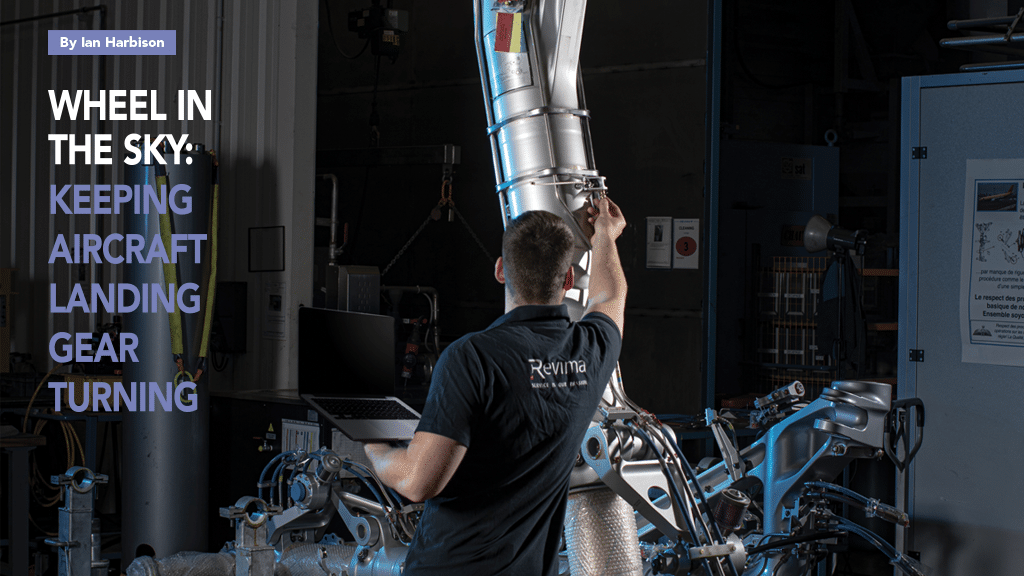The landing gear MRO business is in a state of flux at the moment. With a typical overhaul interval of 10 years or 25,000 cycles, demand can be forecast with some accuracy based on historical aircraft delivery patterns. However, while the high utilization of low-cost carriers means that the period can be reduced to eight years, the pattern has been further distorted by many airlines having delayed maintenance during the pandemic but are now back flying at previous rates. As a result, demand is extremely high at the moment but, on the MRO side, companies are still facing post-Covid staff shortages and replacement training requirements as well as some supply chain issues, extending turnaround times. Looking further ahead, it seems likely that the 10-year limit may be extended to 12 years.
Revima
Olivier Legrand, group president and CEO of Revima, says the main facility at Caudebec-en-Caux, in northern France, which handles landing gear for Airbus (A300-600R, A320 Family and A330) and Boeing (747-400 F/ER/ERF, 747-8, 777, 787 and MD-11), overhauled 350 legs last year. Two thirds of these were for widebodies, which require 2.5 times as many man-hours as narrowbody landing gears. This year, the forecast is a throughput of 420 legs, a 20% increase.

He says the A300-600R and MD-11 markets are pretty flat, although the company has long-term contracts with cargo operators that are keeping the aircraft in service. The MD-11 work may receive a boost with the closure of Hawker Pacific Aerospace (see below), as Revima will be the only MRO source. The 747 market, again mostly cargo aircraft, has stayed around longer than expected but will probably start to decline in the near future.
The largest volume of work comes from the 777-300ER, with the number of contracts probably making the company the largest MRO provider. However, the 787 is set for significant growth, not least because Revima is a member of the Boeing Landing Gear Program. It will replace the 747 and will eventually become the main product in place of the 777. Overhauls now are from the 787-8 but the first 787-9 overhauls will start appearing in the next two years.
Introduction of the 787 has required significant investment. The legs are chrome free, using High Velocity Oxygen Fuel (HVOF) spraying to provide a greener and tougher surface. As machines have become due for replacement, the new equipment must be able to deal with the harder surface. Last year, this included a brand new CNC grinding machine and lathe, while a large grinder is scheduled for delivery in 2024 and a large boring machine in 2025. He notes that the surface on legs coming back for overhaul has been in good condition so investing in HVOF spraying equipment is not a priority at the moment. Another environmental initiative under development is the replacement of cadmium plating with zinc nickel plating, in accordance with the EU REACH program.
Turning to the post-Covid challenges, he feels the company could have handled more than 350 legs last year but for supply chain issues, where components that had always been available were suddenly unavailable. As a result, the company has had to spend an increased amount of time chasing suppliers, developing and proposing workarounds, sourcing used serviceable material, developing repairs and requesting OEM engineering assistance for consideration of adjusted tolerances. In addition, while some 500 people work on landing gear and the company suffered relatively few personnel losses because of its rural location, there was still a training requirement for new hires.
To complement its landing gear MRO services, Revima’s Normandy Aerospares business (the Used Serviceable Material entity of the Group) devoted a portion of its Yainville facilities (7 miles away from the Caudebec site) to carry out landing gear overhaul, especially with mid-life solutions. The market demand for these services is high, but, by its nature, is opportunistic, which did not work well with more planned MRO flow at the main facility.
Rémy Maitam is president, Asia Pacific at the company’s satellite facility in Thailand, at Chonburi, 60 miles north of U-Tapao–Rayong–Pattaya International Airport. It specializes in Airbus A320 Family and Boeing 737NG landing gear, although an agreement signed with Liebherr-Aerospace in April 2023 will see it expand into Airbus A350 nose landing gear MRO in Asia-Pacific. Construction of the 120,000ft2 facility began in February 2019 and was completed in March 2020. In parallel, there was a significant staffing and training program, with local recruits being trained at Revima headquarters. Staff from France also relocated to Chonburi to oversee initial maintenance. Now, he says, the staff are almost entirely Thai, supplemented by specialists from Hong Kong, the Philippines and Singapore.
The $40 million facility is equipped with the latest machinery and tooling, fully connected for smart monitoring and maintenance processes. It is environmentally friendly, with wide use of green chemicals and no waste rejection for its plating facilities. It is also equipped with brand-new machining and test equipment, to high performance non-destructive equipment. Annual capacity is up to 600 legs.
Part 145 certification (Civil Aviation Authority of Thailand, EASA, FAA) was achieved in early 2021 but capabilities were limited to disassembly and assembly, parts repair being outsourced to France. By mid-2022, full capabilities were available after plating and machining shops were added, including five-axis milling and grinding machines, hydraulic test benches and NDT.
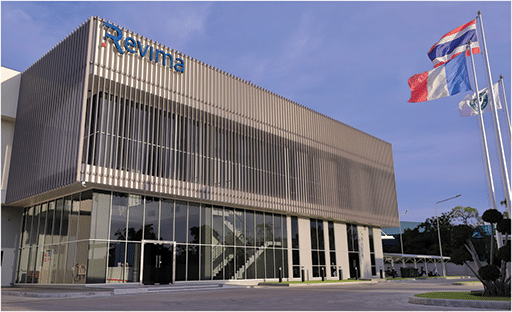
Since then, operations have been in full swing, with 140 legs overhauled last year and 240 forecast for this year. The company counts low-cost carriers amongst its more than 30 regional customers, such as Citilink in Indonesia, AirAsia and its affiliate airlines AirAsia Cambodia, Thai AirAsia, Indonesia AirAsia, and Philippines AirAsia. As a result, he expects high throughput until early-2026, followed by a drop until work picks up again in late 2026/7. To fill the gap, it needs what he calls ‘spot opportunities’, such as a smaller airline or a single aircraft, even a single leg, perhaps after a hard landing. Again, aircraft delivery patterns can help identify potential clients.
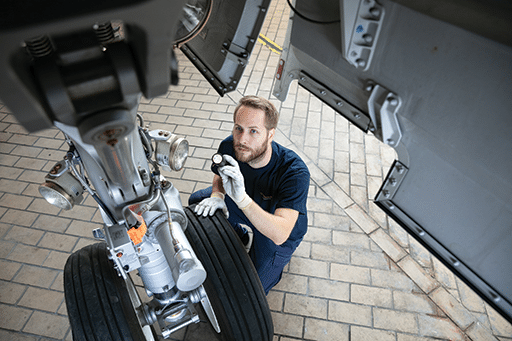
The company has noticed increased corrosion levels on some recent landing gear, which may be related to aircraft grounding during the pandemic. He explains that, after removing corrosion, oversized bushings have to be installed in the leg barrels to keep the required diameter.
The facility is environmentally friendly, with widespread use of green chemicals and no waste rejection for its plating facilities. It will follow the lead from France in the future and replace cadmium plating with zinc nickel plating and hard chrome by HVOF coatings.
LTLGS
For Lufthansa Technik’s Landing Gear Services division (LTLGS), part of the Aircraft Component Services business segment, a major change is coming. Work is carried out at three locations at present:
LTLGS UK in London, located near Heathrow airport: predominantly Boeing (737, 767 and 777, the last 747 and 757 gears having been overhauled last year. The exception is the Airbus A380, with Collins wing- and belly-mounted main gear (four legs in total). Nose gear MRO for the A380 is the exclusive preserve of the OEM, Safran.
LTLGS Hamburg: predominantly Airbus (A320 Family, A330 and A340). The A350 is missing as, assuming the same 12-year replacement cycle as the A380, and with entry into service in early 2015, there is no need to build up landing gear overhaul capabilities just yet.
Hawker Pacific Aerospace in Sun Valley, California, which specialized in Airbus A300, A320, Embraer E-Jets and McDonnell Douglas DC-10/MD-11.
Unfortunately, Hawker Pacific Aerospace, which was acquired in 2002, has suffered years of financial difficulties, primarily because of work on legacy aircraft and a small market share. It has now been decided to wind down and eventually close it by 2025. The facility will stop taking in new gears in March at the latest, with closure in the summer months of 2024 after work is completed. The final closure is planned for some time in 2025. The aim is to fulfil all customer orders until the end of operations and to reach agreements on existing contracts. Lufthansa Technik’s management made sure that the company has established a comprehensive separation and incentive program for its employees, with the possibility to transfer to any other Lufthansa Group company.
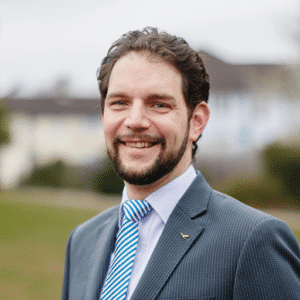
Christian Rodarius, managing director/CEO of LTLGS UK points out that despite the difficult decision to wind down the operation of Hawker Pacific in the U.S., , the rest of the Lufthansa Technik Landing Gear network in London and Hamburg is flourishing. With work coming in from almost all the Lufthansa Group airlines (Lufthansa, Austrian Airlines, Eurowings and SWISS) as well as a worldwide customer base of passenger and cargo airlines, leasing companies and MROs, the workload is high, with around 350 legs processed last year in each of both locations. In addition, LTLGS also offers AOG support, an exchange pool for gear legs and a spares pool.
He says Covid caused some problems but a good throughput was maintained. This was helped by the size of Lufthansa Technik and its market power; even with supply chain problems, having a centralized purchasing process for the whole group is a huge advantage.
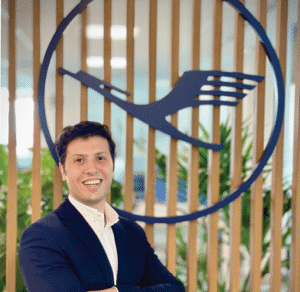
The Heathrow facility was previously owned by British Airways, dating back to Concorde days, although it has been extensively redesigned and upgraded since then, using Lean principles to form a U-shaped line inside the building, from goods inward to dispatch. Jad Kaakani, head of product line landing gear at LTLGS UK, explains that gears are cleaned, stripped and disassembled before inspection. Initially, they are placed on black trolleys, switching to yellow for inspection and purple for the rest of the process. Once the workscope has been established, piece parts are sent to various sections for repair and overhaul. They are accompanied by paperwork at every stage to avoid any omissions and to build a database that can help predict what will be required on a leg of a similar age.
The machine shop, with CNC grinders, can manage a range of tasks, including the manufacture of bushes and thread repair. The plating shop uses cadmium, chrome, Alucrom and nickel. Although the Heathrow facility is no longer in the EU, it still follows REACH program requirements. After final paint and inspection, the components come back together in an assembly area that has eight widebody and four narrowbody bays.
Kaakani says it is important to keep the facility constantly loaded and, indeed, the empty goods inward area at the start of the walkround had received a 777 main landing gear by the tour’s end.
